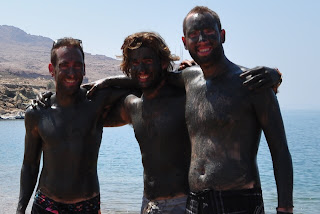Aug 13-16
After an hour cab ride to Aqaba, a 5-hour bus ride to Amman and then two more cab rides, we finally arrived in the city of Madaba.
Madaba is located 30km southwest of Amman, but provides a laid-back alternative to the bustling capital. It is also the Christian capital of Jordan, with around one third of its inhabitants calling Jesus their saviour. The sparse city-center skyline is dominated by the bell tower of the catholic church and the two minarets of the central mosque.
We managed to get one of the few rooms available in the city. The following nights, however, we had booked at the wonderful Queen Ayola hotel.
On our first full day in Madaba, one of Queen Ayola's owners, Fadi, gave us a tour of Madaba's Catholic church, with its Byzantine-era ruins as well as the Madaba museum.
Since we were quickly mosaiced-out, we decided to leave Madaba for the day and head towards the Dead Sea. Our first stop was Mount Nebo, where Moses supposedly was shown the promised land and where he was apparently buried.
From there, our driver stopped along the Dead Sea highway and we descended along a rocky path to the banks of the Dead Sea. From out of nowhere, our driver pulls out a bag full of special Dead Sea mud and we inadvertently and unfortunately ended up looking like blackface from the turn of the century.
Swimming in it is a truly bizarre experience, feeling like you're in suspended animation rather than sea water. We spent a good while trying ridiculous positions and seemingly impossible configurations.
Our next stop was Wadi Zarqa Ma'in, a 2-hour trek upstream through the Hammamet Ma'in hot-spring-fed river: imagine hiking up a jacuzzi river in 45 degree heat. Great, but dehydrating to say the least!
Our day culminated with a beautiful panorama view of the Dead Sea and surrounding valley. Now I'm not a religious person, but this area could definitely inspire many people to believe in something greater than themselves.
Holy Land indeed!















No comments:
Post a Comment